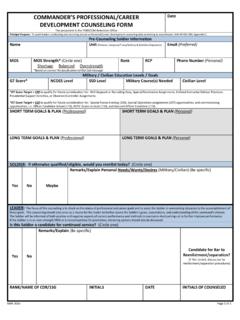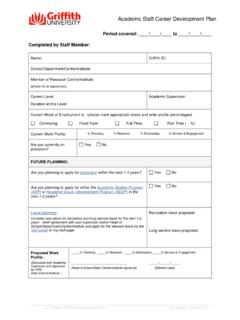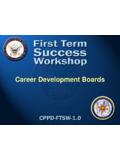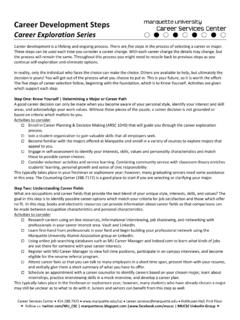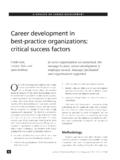Transcription of Skill Development Career Pathway and Cluster - …
1 Please cite this paper as:Hamilton, V. (2012), Career Pathway and Cluster SkillDevelopment: Promising Models from the United States ,OECD Local Economic and Employment Development (LEED) Working Papers, 2012/14, OECD Local Economic andEmployment Development (LEED)Working Papers 2012/14 Career Pathway and ClusterSkill DevelopmentPROMISING MODELS FROM THE UNITEDSTATESV irginia Hamilton 2 TABLE OF CONTENTS BACKGROUND AND CONTEXT .. 4 Introduction .. 4 The Current Environment .. 5 Career PATHWAYS AND Cluster APPROACHES .. 8 What is a Career Pathway ? .. 8 What is a Career Cluster ? .. 9 EXAMPLES OF LOCAL AND STATE LEVEL INITIATIVES .. 11 Pathway Models .. 11 Cluster Models .. 15 LESSONS LEARNED AND POLICY IMPLICATIONS .. 24 CONCLUSION .. 28 BIBLIOGRAPHY .. 29 Tables Table 1. Excerpt from the 2009-2010 Career Clusters Course Description Booklet .. 19 Table 2. Features and Benefits of Maryland Career Clusters .. 22 Figures Figure 1.
2 K-12 Education (34 states plus DC) .. 6 Figure 2. Higher Education (43 states) .. 6 Figure 3. State Workforce (44 states plus DC) .. 7 Figure 4. Fresno California /PG&E's PowerPathway Model .. 12 Figure 5. Oregon Career Pathways .. 15 Figure 6. Colorado Career Cluster Model .. 18 Figure 7. Nebraska Cluster Model .. 20 3 Boxes Box 1. Career Pathway Programmes .. 9 Box 2. Department of Education Industry Clusters .. 10 Box 3. Clusters of Opportunity Methodology .. 16 4 BACKGROUND AND CONTEXT Introduction This paper looks at states and localities in the United States that are focusing their workforce and education programmes on Career pathways and clusters. It describes how these approaches align with economic Development strategies and can benefit employers and individuals in the labour market. It points to some of the successes and challenges being experienced by Workforce Investment Boards, Community Colleges and the K-12 education system.
3 It also highlights several regions where sufficient commitment and investment in Career Pathway and Career Cluster models has caused real system change in filling the Skill needs of employers. Often, this system change requires investment, leadership, best practice models, and partnerships. In the United States, local and regional government agencies have increasingly adopted industry Cluster approaches to economic Development . This framework allows economic Development agencies to study and understand groups of companies, along with other regional assets such as universities, which have evolved into an ecosystem of interdependence in a region. An industry Cluster framework enables the Development of approaches targeted to retaining and growing high value employment, increasing the tax base, and attracting new jobs to the region. Stepping back from specific companies and industries, and examining the entire ecosystem of industries that support each other allows scarce economic Development resources to be deployed more effectively.
4 A similar move towards industry Cluster approaches is surfacing in the employment and workforce Development field. Education and workforce agencies are critical partners in mapping and building Skill pipelines for key industries. Local partnerships within key industry sectors are yielding strategies to provide workers with the skills necessary to increase productivity and job creation in regions. This allows economic Development agencies to market the talent of the region, and to develop aligned retention and attraction strategies. In addition to Cluster approaches, employment and workforce Development actors are also using Pathway models, which provide a clear progression of courses for learners towards achieving a designated credential in a particular occupation within a Cluster . Often, these Pathway approaches are implemented through a partnership between secondary and post secondary education stakeholders as well as employers.
5 Cluster and Pathway approaches are important in an increasingly complex and fragmented labour market where employees no longer move in a straight line within one company, but rather move vertically and horizontally around a set of jobs. Maps of industry clusters and pathways, which outline associated Skill requirements, are incredibly useful tools for those in the labour market and those entering the labour market. Cluster and pathways models are also a way for the public education and workforce system to categorise and organise their work. For high schools and community colleges, participating in Career Cluster and Pathway models helps to connect them to the local economy and produce workers with the appropriate skills for jobs in the region. 5 The Current Environment In order to better understand the potential for transferable examples to other OECD countries, it is important to provide some background and policy context.
6 Designing programmes to respond to the dynamic nature of the economy in the United States with its shifting needs is a constant challenge. Not since the Great Depression have unemployment rates been as high and persistent as they are presently - the unemployment rate for June 2012 was per cent (Bureau of Labour Statistics, 2012). According to Sum (2011), there has been a downward trend in youth unemployment, which is particularly worrying as work experience for youth often leads to greater labour force attachment. Statistics for youth unemployment highlight the magnitude of the problem. Aggregate teen employment continued to fall for the fourth consecutive year and helped drive up the youth unemployment rate to just under 26 per cent - the highest it has been in the past 62 years for which data on unemployment rates are available (Bureau of Labour Statistics, 2012).
7 In spite of the current high rates of unemployment, employers in the United States report a growing skills gap. This would indicate that the education and training system may not be responding to employer demand. According to a recent survey conducted by Bridgeland et al (2011), more than half (53 per cent) of business leaders say their companies face a very or fairly major challenge in recruiting non-managerial employees with the skills, training, and education their company needs, despite millions of Americans seeking jobs at the time of the survey. Those at smaller and medium sized companies who were responsible for over 50 per cent of new jobs created in 2007 felt this most acutely: 67 per cent say it is difficult while only 33 per cent find it easy. The current political and fiscal environment is also creating some real obstacles in building new flexible approaches to Skill Development .
8 The budget deficit at the federal level combined with the Tea Party s conservative anti-government influence in Congress, have shifted the focus of many government programmes away from innovation towards fighting for survival. The House of Representatives in February 2011 voted to remove all funding for the Workforce Investment Act, to substantially cut federal investment in PELL grants (financial aid for students), as well as make deep cuts in other education and workforce funding. Following the House of Representatives vote, the Senate voted to retain but cut all of these programmes. At the State level, Governors and State Legislators are under tremendous pressure to consider huge cuts to education and social programmes as some of the only ways to defray state deficits. As the Centre on Budget and Policy Priorities maps below indicate (see Figures 1-3), almost all of the state governments are making sweeping cuts in education and workforce programmes (states that are shaded grey have made budget cuts related to K-12 education, higher education, and state workforce Development .)
9 As budgets keep shrinking, funding for innovation and the intermediary work required to design and implement cross-system collaboration is more difficult to defend. 6A Difficult Fiscal Environment Figure 1. K-12 Education (34 states plus DC) Source: Centre on Budget and Policy Priorities, Figure 2. Higher Education (43 states) Source: Centre on Budget and Policy Priorities, 7 Figure 3. State Workforce (44 states plus DC) Source: Centre on Budget and Policy Priorities, Another critical issue is the fragmented nature of federal agencies and their funding. According to the United States Government Accountability Office (2011), for fiscal year 2009, there were 47 federally funded employment and training programmes administered across 9 agencies. Rules and regulations about the use of funds, decision making in narrowly focused Congressional committees and a tradition of funding silos makes progress on a national approach to Career pathways and clusters difficult.
10 Innovation and best practices in the United States tend to happen in state and local communities, and once there is enough evidence of success, those approaches are integrated into federal policies and programmes. The challenge for state and local governments, as well as those organisations focused on economic Development is daunting. Even though it appears that there are certain sectors of the economy that are starting to see profits, this jobless recovery has not created anywhere near enough jobs to employ the million individuals in the United States that are still out of work (Bureau of Labour Statistics, 2012). The challenge for those who work with the unemployed, the disadvantaged, low skilled workers, and youth is even greater. Understanding the labour market and which jobs require which skills is more important than ever. Pathways and Cluster approaches that allow the most flexibility for current and potential workers in moving from job to job as the economy changes seem to provide the most promise.











